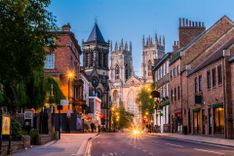The glazes on the celestial spheres, Heather makes from scratch. “There’s a lovely clay man down in Bognor Regis,” says Heather. “He’s the local supplier. I buy all the raw materials from him and make up the glazes in the studio. I’m always looking for ways to be more sustainable, only using resources that come from the Earth.”
Heather picks up a pastel-pink vase, turning it in her hands. “I was down on the beach at the weekend and some ash must have blown in because there was black all against the ripples of sand and it was just beautiful. The sea and sand and weather all influence the creative aesthetic. But I’m more interested in the form and getting the shape right. I was commissioned through my website to make three vases of the same shape, but different sizes. That was tough. Porcelain is my favourite material to work with but it’s not the easiest on the wheel. I had to learn how to throw taller and bigger mainly through YouTube clips and lots of practice.
“Ahem, excuse me,” says Heather, rescuing the cat from the counter. “You know what happened last time,” she says, running her fingers through its dense coat. “I don’t know how she gets up there. And then she jumps down and the whole thing shakes, and I’m like, ‘Rose! Don’t you even think about it’.”
Rose jumps up onto the disused wooden wheel, imploring affection. “My parents bought that old wheel when I was 21. It still works. It’s just very cranky. I probably ought to sell it but it’s a bit sentimental. So, I’m hoping I can recondition it for teaching. This one, however, I bought last year,” says Heather, looking at the neighbouring machine. “It’s called a Shimpo. It’s so quiet.”
Heather recalls having creative tendencies as a child. “Growing up surrounded by clay, with my father working as a sculptor, it was inevitable really, that I’d end up doing something like this. I graduated with a degree in 3D Design: Ceramics from the Bath Academy of Art in the 90s, then had children, then became a teacher. It wasn’t until later that I took ceramics more seriously.
“That passion doesn’t leave you even after having four children. I bought this house, set up my studio and it’s gone from there."
Heather now spends her spare time in the studio, around teaching at a local primary school.
“I’m in here whenever I can,” says Heather. “More so in spring, summer and autumn when it’s warmer and you can make something in a day. It’s great mindfulness stuff. People are doing it as an escape from the madness of the world.”
“I also belong to the Southern Ceramic Group, which started up in the 70s and has just grown and grown all along the South Coast. Around 40–50 of us get together for an annual exhibition at Chichester Cathedral. It’s great. You get a real variety of styles coming together. That was cancelled this year for obvious reasons. The Chichester Art Trail got cancelled too – that would have been my first. I’m hoping to run a stall at Draper’s Yard, Chichester soon. They are really trying to promote local artists.”
Heather pulls a pot from the electric kiln and walks over to the glaze tests for colour inspiration. "Ceramics, it’s just my thing. Here, I can just forget everything and get into what I’m doing and just focus on that. I’m just glad I’ve found it again.”
















